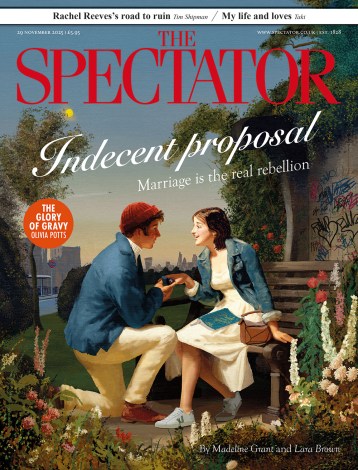
I started counting magpies during my brief, doomed time as a history teacher. Trudging in every morning, the grim prospect of Weimer Germany with the Year 11s ahead, I began to take note of the number I spotted. If, on first sight, I spied only one, I knew I would have a terrible day. If I saw two, it would be lovely. If I spotted one, saluted furiously, said ‘Hello Captain’, told him the date, and then saw two, I might be all right.
I’m not usually superstitious (I’m pessimistic enough to assume that everything usually turns out for the worst), so I’m not sure where this habit came from. Unfortunately, it is very hard to shift. Crossing St James’s Park each morning to reach the Spectator office means navigating a minefield of awkward salutes and mumbled hellos.
Every reader will know the nursery rhyme: ‘One for sorrow/ Two for joy/ Three for a girl/ Four for a boy/ Five for silver/ Six for gold/ Seven for a secret never to be told.’ The first records of it date from 1780: one in John Brand’s Observations On Popular Antiquities – a collection of English folklore – and another in Samuel Johnson’s edition of Shakespeare plays. Regional variations persist. Lancashire’s goes up to 13 – ‘Beware, it’s the Devil himself’.
This final verse is appropriate, since magpie suspicions have Christian origins. The Ancients held the magpie in quite high regard; the Romans admired its cleverness, and the Greeks associated it with Bacchus, the god of wine. Yet the Church turned against it, teaching that the magpie was the only bird that failed to cry during Christ’s crucifixion. Piero della Francesca’s ‘Nativity’ features a single magpie, foreshadowing Mary’s sorrow at the foot of the cross.
Superstitions about magpies abounded. It was said they could speak like humans; that they refused to enter Noah’s Ark, perching and swearing outside; that they carry drops of the Devil’s blood in their tongues. Magpies hardly helped themselves, being often spotted stealing shiny possessions, scavenging near battlefields or gallows or preying upon pheasants’ nests.
But why the counting? A possible explanation was given by the chemist Humphry Davy in an 1828 work on fly-fishing. On a stormy day, a single magpie leaves the nest, while the other remains to guard the eggs. But on a pleasant day – good for fishing – both magpies head out. Quaint, but the more obvious reason is that magpies mate for life, so a lonely one suggests misfortune.
Various strategies have been developed for coping with magpie-mania, from doffing your cap and asking ‘Good morning, Mr Magpie, how is your lady wife today?’, to spitting three times over your shoulder, to flapping your arms and mimicking the bird’s call. In Somerset, carrying an onion was once believed to be sufficient to guard against their bad luck.
Perhaps we’ve misjudged magpies. After all, the mistrust is a distinctly western phenomenon. In East Asia, they are symbols of good fortune. According to Chinese folklore, each year magpies fly to the Milky Way to form a bridge enabling a cowherd and weaver girl to continue a forbidden romance.
Nor do magpies deserve their reputations as pilferers of all things shiny. A recent Exeter University study found that they are frightened by unfamiliar objects, and especially shiny ones. But even if they aren’t really an ill omen, I’ll keep on saluting, just to be on the safe side.








Comments